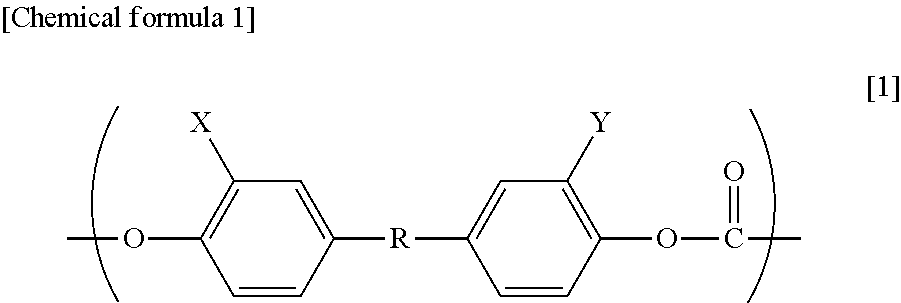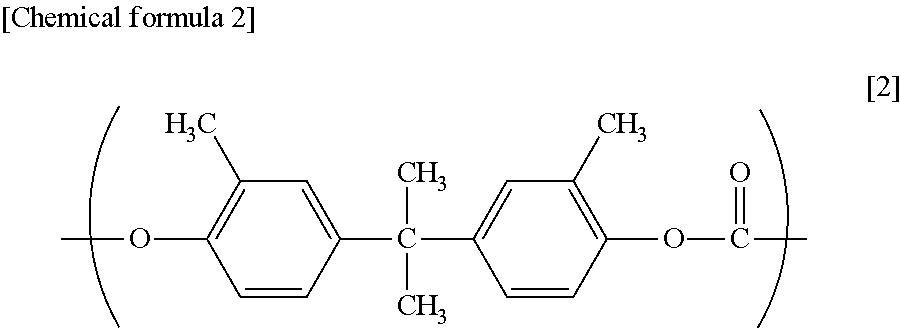Synthetic resin laminate
a synthetic resin and laminate technology, applied in the field of synthetic resin laminates, can solve the problems of low surface hardness, high scratch resistance, and allowing the surface of the molded body to be easily scratched, and achieve the effects of high thermoformability, high flexibility, and high surface hardness
- Summary
- Abstract
- Description
- Claims
- Application Information
AI Technical Summary
Benefits of technology
Problems solved by technology
Method used
Image
Examples
synthesis example 1
Synthesis of 2,2-bis(4-hydroxy-3-methylphenyl)propane / 2,2-bis(4-hydroxyphenyl)propane=6 / 4 copolymer polycarbonate
[0132]6174.7 g (24.12 mol) of 2,2-bis(4-hydroxy-3-methylphenyl)propane (produced by Honshu Chemical Industry Co., Ltd.), 4086 g (17.98 mol) of 2,2-bis(4-hydroxyphenyl)propane (produced by Nippon Steel Chemical Co., Ltd.), 3.8 g of triethylbenzylammoniumchloride, and 50.0 g of hydrosulfite were dissolved in 54.5 L of 9.0 w / w % aqueous solution of sodium hydroxide.
[0133]24 L of methylene chloride was added thereto and stirred, and then 5390 g of phosgene was blown thereinto over 40 minutes while the temperature was kept at 15° C.
[0134]After the blowing of phosgene was finished, 210 g of p-t-butylphenol was added thereto and stirred vigorously to emulsify the reaction solution. After the emulsion, 110 ml of triethylamine was added thereto and stirred at a temperature of 20 to 25° C. for about 1 hour to cause polymerization.
[0135]After the polymerization was finished, the rea...
production example 1
Production of Resin (a11) Pellet
[0136]40% by mass of Metablen H-880 (produced by Mitsubishi Rayon Co., Ltd.; weight-average molecular weight: 14,000; a11 / a12=33 / 66) as the (meth)acrylate copolymer (a1) and 60% by mass of the polycarbonate resin (a2) produced in synthesis example 1 were put into, and mixed by, a blender for 20 minutes, melt-kneaded at a cylinder temperature of 260° C. by use of a biaxial extruder having a screw diameter of 35 mm, extruded into a strand, and formed into a pellet by a pelletizer. The pellet was stably produced. The glass transition temperature of the resultant high-hardness resin composition was measured and found to have a single peak at 119° C. Based on this, it was confirmed that the components of the resin composition were in a compatible state.
production example 2
Production of Resin (A12) Pellet
[0137]30% by mass of the (meth)acrylate copolymer used in production example 1 and 70% by mass of the polycarbonate resin (a2) produced in synthesis example 1 were mixed and pelletized. The pelletization was performed under substantially the same conditions as those in production example 1. The pellet was stably produced. The glass transition temperature of the resultant resin composition was measured and found to have a single peak at 124° C. Based on this, it was confirmed that the components of the resin composition were in a compatible state.
PUM
| Property | Measurement | Unit |
|---|---|---|
| Tg | aaaaa | aaaaa |
| thickness | aaaaa | aaaaa |
| thickness | aaaaa | aaaaa |
Abstract
Description
Claims
Application Information
 Login to View More
Login to View More - R&D
- Intellectual Property
- Life Sciences
- Materials
- Tech Scout
- Unparalleled Data Quality
- Higher Quality Content
- 60% Fewer Hallucinations
Browse by: Latest US Patents, China's latest patents, Technical Efficacy Thesaurus, Application Domain, Technology Topic, Popular Technical Reports.
© 2025 PatSnap. All rights reserved.Legal|Privacy policy|Modern Slavery Act Transparency Statement|Sitemap|About US| Contact US: help@patsnap.com



